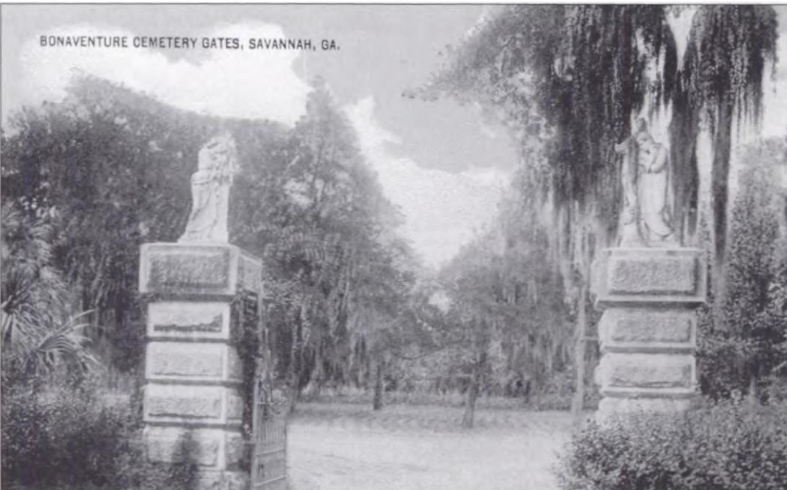Old cemeteries can seem like sad places, but in places like Savannah, Georgia, they can also serve as a portal to history. Every year, tourists from all over the world visit Bonaventure Cemetery to learn the stories of the town’s most intriguing residents.
This beautiful graveyard contains stunning memorial sites that have informed the cultural landscape of the town. The gothic statues, hanging Spanish moss, and dramatic trees create an unforgettable experience for visitors.
The cemetery has a storied history worth exploring. While it began as a private, family-owned plantation, it is now a public cemetery, where Savannah residents can purchase interment rights for their final resting place.
The Beginnings of Bonaventure
The Bonaventure estate was originally a private plantation named Evergreen, a name that changed after the American Revolution. It spanned over 60 acres, and the owner, John Mullryne, who was a British loyalist, played an active role in politics.

Fortune seemed to be on Mullryne’s side when he first settled in his new home on Saint Augustine Creek. He built the Tybee lighthouse in those early years, earning the admiration of his fellow citizens.
However, this prosperity did not last long. At the onset of the Revolutionary War, American patriots branded British loyalists as traitors. Soon afterwards, local authorities starting seizing property and auctioning it to the public, including the land of Mullryne and his son-in-law, Josiah Tattnall.
Tattnall later reacquired the property and gave the plantation the name Bonaventure, which means “good fortune” in French. The family lived there until 1803 when the last member of the lineage passed away. The Tattnalls were the first family to be buried on the property.
Later years at Bonaventure
Over the years, Bonaventure changed hands several times. The property remained private until 1846, when a wealthy hotel owner named Pete Wiltberger bought the place. It was Wiltberger who thought to include a large part of the land as part of a seventy-acre cemetery. He incorporated the ruins of the original plantation house, using the beautiful, oak-lined roads to separate the cemetery into different sections.
In 1907 the city purchased the land and made it an official, public cemetery.
The Cemetery
In his book, A Thousand Mile Walk to the Gulf, naturalist John Muir wrote:
“Bonaventure is called a graveyard, a town of the dead, but the few graves are powerless in such a depth of life. The rippling of living waters, the song of birds, the joyous confidence of flowers, the calm, undisturbable grandeur of the oaks, mark this place of graves as one of the Lord’s most favored abodes of life and light.”
Yet, the words from his book only touch on the intense level of inspiration one feels once entering the grounds. The paths are home to butterflies, birds, endless roses and azaleas, snakes, and dark oak trees that tower over its visitors. The Spanish moss that hangs from the trees adds to the haunting Gothic effect, enticing you to walk deeper into the cemetery.
Muir slept on graves in the cemetery when he was broke, disregarding the local tales about phantoms wandering the grounds. He claimed it was “an ideal place for a penniless wanderer,” and said he felt closer to God while there.
The beautiful statues, local legends, and the cemetery’s reputation make any visit to Bonaventure Cemetery truly thrilling.
A Legend of Bonaventure
One of the most famous statues from the cemetery is known as Little Wendy, also known as Bird Girl. Visitors may recognize her from the cover of the popular 1994 book, Midnight in the Garden of Good and Evil by John Berendt.
The statue Little Wendy stands with a bowl in each hand and her head inclined to one side. The sculptor supposedly modeled her after Little Gracie Watson, the beloved daughter of a hotel owner, who died at a very young age in 1889. The sculptor, John Walz, created the life-size memorial using only a photograph, and this statue has captured the interest of every visitor to the cemetery.
Many locals claim the ghost of Little Gracie haunts her plot. For years, people have reported seeing a little girl that fits her description playing in Johnson Square, where her father’s hotel once stood. The legend claims she appears as a normal, living girl in a white dress who vanishes without a trace when you get too close.
Many famous people have been laid to rest there, including notable author Conrad Aiken, and the singer/songwriter Johnny Mercer. Bonaventure Cemetery continues to delight people with its stunning memorial sites and the rich tapestry of the southern residents that call it home. Bonaventure Cemetery may contain some haunted legacies, but it is an enchanting place that transfixes every visitor that enters its gate.

